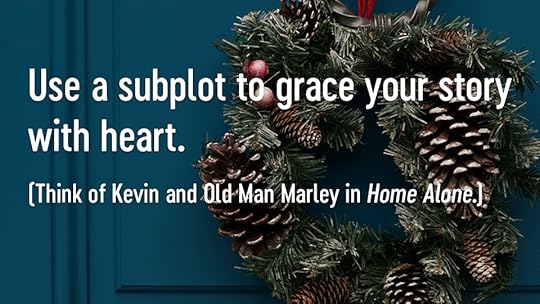Your “Easy As Pie” Guide to Subplots + Giveaway (Part 1 of 3)
by H.R. D’Costa, @scribesworld
Have you ever tried to make a pie crust from scratch?
In my experience, when you press the dough into the pie pan, there’ll be areas where the dough is thick and knobby, almost like the hills of a tea plantation…
…and there’ll be areas where the dough is thin.
So, so thin.
Working with the main plot of your novel can be like that.
There’s only so much of it to go around.
After a certain point, if you try to extract more out of it, you’ll stretch it too thin. You’ll end up with plot points that are bland and repetitious.
Savvy writers recognize this.
They don’t try to extract more than their main plot can give.
Instead, they take a break from the main plot. Like bakers who take scraps of dough to fill in holes in a pie crust, these writers fill their pages with other material.
This is where subplots—secondary stories that are subordinate to the main plot—come in. (Sometimes, a subplot is referred to as the B-story, while the main plot is referred to as the A-story.)
Subplots are one of the best ways to get your novel to the right length, without stretching your main plot too thin.
Of course, you can’t be obvious about it. Then your subplots will feel like filler—and your readers will get bored and start skipping pages.
Not good.
However, readers will be less likely to deem your subplot a stall tactic (even though that’s exactly what it may be)—if you integrate it skillfully into your story.
That’s what this “easy as pie” guide to subplots is all about. With it, you should pick up some tips so that your subplots enhance—rather than detract from—the main plot.
The guide is divided into three parts. Below is a quick overview:
In Part 1, we’ll cover 5 uses for subplots (you’re reading Part 1 now).
In Part 2 (forthcoming), we’ll cover how to structure your subplots (plus the golden rule to follow regarding subplots).
In Part 3 (forthcoming), we’ll cover how to weave subplots into your story as well as conduct a subplot “safety check.”
Note: These subplot tips have been adapted from my writing guide Sparkling Story Drafts, which will help you write cleaner rough drafts, reduce your revision time, and get a crazy-good story onto the marketplace—faster. To learn how you could win a paperback copy, see the end of this post.
Ready? Grab a fork, and let’s dig in!
5 Uses for Subplots
If your subplot has an additional function—if it’s not just a stall tactic—then it’s more likely to feel integral to your story…
…and less likely to feel like filler.
Makes sense, right?
So now it’s time to figure out what kind of contribution you want your subplot to make.
Because subplots are flexible, you have multiple options at your disposal. Below are 5 suggestions to get you started.
Use a subplot to:
Elucidate theme or convey character arc. One of my favorite examples is from What Women Want. I love how the subplot between Nick and his daughter demonstrates how much Nick has changed.
Speaking of change…
…in a post on working with theme, Elizabeth mentions exploring “whether the victim in the book had really changed his stripes before he was murdered (as he swore he had).”
Sounds like great subplot material to me!
Increase emotional involvement by highlighting the stakes. Think of the senator’s kidnapped daughter in Silence of the Lambs.
Increase emotional involvement in a subtler fashion by gracing a story with heart. While the hijinks of Home Alone are fun, the heartwarming relationship between Kevin and Old Man Marley elevates the film into something more.
Update readers about reoccurring characters in a series. Fans of a series don’t just invest in the protagonist of the series. They also invest in the supporting cast.
A subplot can provide a great opportunity for fans to reconnect with the characters they love.
Quick tip: to create this kind of subplot, pick a series trope that involves a reoccurring character and build your subplot from there.
Conceal a clue or create red herrings and plot twists. A subplot built around a romance with a new lover yields plot twists in The Verdict, The Devil Wears Prada, and The Dark Knight Rises.
To get a subplot worksheet that conveniently lists all of these uses (plus more!), sign up here.
By the way, there’s nothing wrong with combining multiple functions under the same subplot. In fact, this approach can give your story greater depth and focus, preventing it from turning into one big sprawl.
Now that you’ve sorted out the content of your subplot, it’s time to reflect on its structure. That’s what we’ll cover in Part 2 of this subplot series. Stay tuned!
Win a Paperback Copy of Sparkling Story Drafts
Three different opportunities to win—here’s opportunity #1!
For every post in this series, you have a chance to win a paperback copy of Sparkling Story Drafts ($24.99), which will help you write cleaner rough drafts, reduce your revision time, and get a crazy-good story onto the marketplace—faster.
For a chance to win today, answer this question in the comments: Have you ever used a subplot for one of the purposes listed in this article? If not, what purpose did you use your subplot for?
Elizabeth will randomly select a winner from the comments by Wednesday, January 23.
Note: This giveaway is only open to residents of North America, South America, Europe, and the UK.
Good luck and happy writing!
Author Bio
A graduate of Brown University, H. R. D’Costa (a.k.a. HRD) almost became a lawyer. Twice. But then she realized that although she wanted to be a lawyer, she needed to be a writer. So she dedicated herself to studying films, screenplays, and novels in order to understand why some stories were gripping…while others were easy to walk away from.
Ultimately, she shared her discoveries in eight writing guides, including Sizzling Story Outlines: How to Outline Your Screenplay or Novel, Always Know “What Happens Next,” and Finish Your Rough Draft Without Freaking Out and Story Stakes: Your #1 Writing Skills Strategy to Produce a Page-Turner that Transforms Readers into Raving Fans of Your Screenplay or Novel, which one Amazon reviewer described as “a must-have in your top 10 books on writing.”
For practical, actionable writing tips designed to help you keep readers glued to your pages, visit her website scribemeetsworld.com, which is also home to the Ultimate Story Structure Worksheet (downloaded over 37,000 times by writers from around the world). Get it here.
5 Uses for Subplots from @scribesworld:
Click To Tweet
Lattice-style pie by Dilyara Garifullina; Evergreen wreath by Erwan Hesry
The post Your “Easy As Pie” Guide to Subplots + Giveaway (Part 1 of 3) appeared first on Elizabeth Spann Craig.







